#Artifact 2019
Explore tagged Tumblr posts
Photo

Field Creeper
As it walks across the fallow field, its awkward, loping gait matches the rattling in its head to create a haunting rhythm that chills the bones.
Artist: Anthony Palumbo TCG Player Link Scryfall Link EDHREC Link
#mtg#magic the gathering#tcg#$0.05#anthony palumbo#field creeper#core set 2019#artifact#creature#scarecrow
31 notes
·
View notes
Text


redraw/ redesigns of some old ocs (evelyn and rita!) i did as a warm up!
close ups/ side by side under the cut


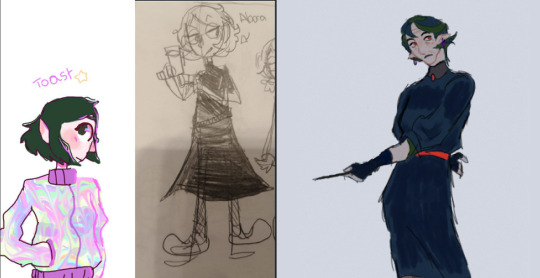
(2018-2019/ 2024)
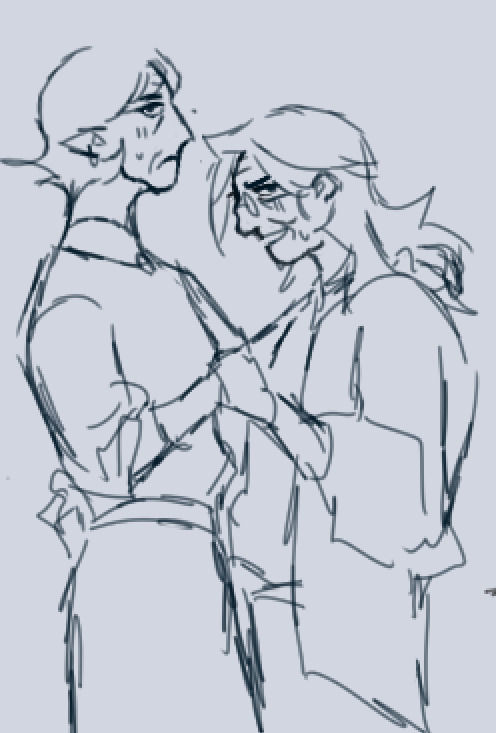
also these silly old women are in love! :]
#these are some of my oldest like actual ocs with story and stuff i have em since 10 i think!!#but i just havent drawn em properly since 2019 i think#i was hit with a wave of nostalgia and started looking through old sketchbooks n such and i really wanted to redesign em!#it looks that i aged em up but they where supposed to b old (i think evelyn was supposed 2 b 50 and rita 52 aa)#also some rambles abt em srry#evelyn is a retired adventurer and con-artist (not really retired from that one) she collects magical artifacts and resells em#or often bootlegs magical artifacts and resells em#rita used 2 be a fairy but lost her wings she and evelyn used to b adventure partners in their younger years but they had a bad fall off#she is now a magician and also a rival of evelyn's business of selling magical artifacts#okay that's it abt my silly ocs srry 👍#worm out!!!!#oc#oc art
6 notes
·
View notes
Text
476,000 years ago
"To date these objects, the researchers analyzed minerals in the sand that surrounded them through a technique called luminescence dating, Geoff Duller, a co-author of the study and dating expert at Aberystwyth University in Wales, tells the AP. The smaller wooden objects were buried around 390,000 and 324,000 years ago."
There are good pics and diagrams of the finds in this Nature article. Found tools - flake tools, cleavers, handaxes and core axes - and the wooden structure. "This construction has no known parallels in the African or Eurasian Palaeolithic."
"...before this new find, the oldest known structure made of wood was only 9,000 years old.." Smithsonian
#archeology#Kalambo Falls#zambia#wooden artifacts#hand tools#oldest human building#2019#early stone age
3 notes
·
View notes
Text
Panama Canal Cruise 2019 — Part 2 (ship art and stuff)
Ocean to Ocean Panama Canal Cruise 2019 Previous posts:https://dispersertracks.com/2025/02/13/panama-canal-cruise-2019-part-1/ The first port on our voyage was Puerto Vallarta (see the above map), but it took us two days of sailing to get there. I have a confession to make. Few destinations excite me, and I can say that none are in Mexico. Sure, there are some nice vacation spots, but none I…

View On WordPress
#art#Coral Princess#Cruise Ship#Cruise Ship Decor#Naval artifacts#Paintings#Panama Canal Cruise 2019
0 notes
Text

Oldest Wine Ever Discovered in Liquid Form Found in Untouched Roman Tomb
A 2,000-year-old Roman funerary urn unearthed in southern Spain has been shown to contain the oldest wine ever found still in liquid form.
Discovered during home renovations at a property in Carmona in 2019, the contents of the urn were analyzed by a team of scientists from the University of Cordoba in a study published Monday.
Study lead author José Rafael Ruiz Arrebola, a professor of organic chemistry at the university, said that the urn was found to contain cremated remains, burned ivory thought to come from a funeral pyre and around 4.5 liters (1.2 gallons) of reddish liquid.

“When the archaeologists opened the urn we almost froze,” he said. “It was very surprising.”
The team then carried out a chemical analysis of the liquid and found that it was wine.
This was a big surprise, because wine normally evaporates quickly and is chemically unstable, Ruiz Arrebola said.
“This means it is almost impossible to find what we have found,” he said, explaining that the wine had been preserved by a hermetic seal that prevented it from evaporating, but it is not clear how the seal formed.
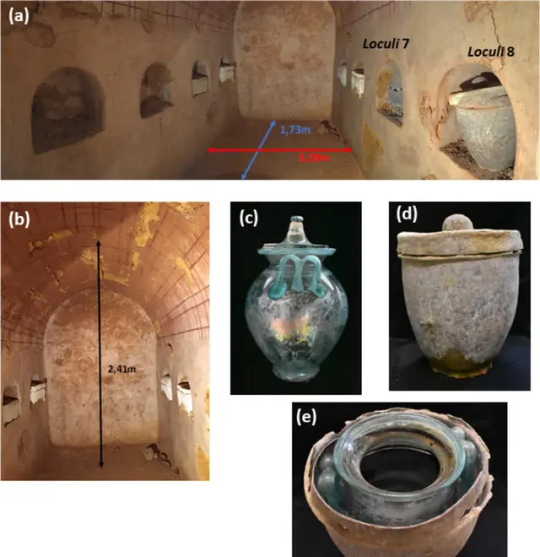
Further chemical analysis allowed the team to identify the liquid as a white wine, as it didn’t contain syringic acid, a substance only present in red wines, Ruiz Arrebola said.
It also has a similar mineral salt composition to the fino wines produced today in the region, he added.
“It’s something unique,” said Ruiz Arrebola. “We have been lucky to find it and analyze it – it’s something you only see once in your life.”
The researchers believe their discovery dethrones the current holder of the record for oldest wine in a liquid state, the Speyer wine bottle, found in Germany, which is thought to be around 1,700 years old. However, the age of the Speyer bottle has not been confirmed by chemical analysis.


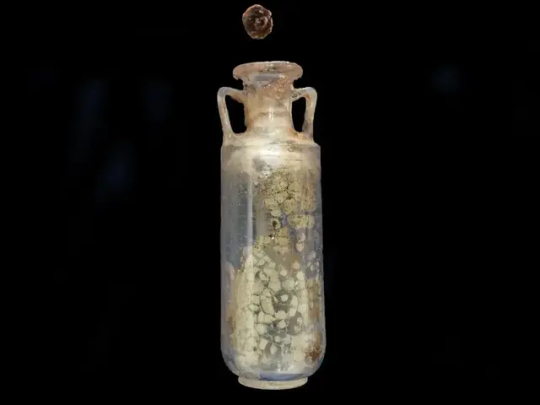
The vessel was one of six funerary urns containing remains found in the mausoleum.
The discovery of a gold ring and other valuable artifacts suggest it was built by a family of considerable wealth, Ruiz Arrebola said.
However, little else is known about their lives, because cremation would have destroyed any DNA, he explained, adding that this means it is impossible to say whether the six people were related.
Ruiz Arrebola now plans to try to work out which modern-day local wine it was most similar to, although there are hundreds to work through.
By Jack Guy.
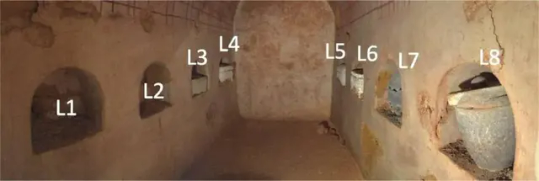
#Oldest Wine Ever Discovered in Liquid Form Found in Untouched Roman Tomb#Carmona Spain#ancient tomb#ancient grave#ancient mausoleum#ancient artifacts#archeology#archeolgst#history#history news#ancient history#ancient culture#ancient civilizations#roman history#roman empire
2K notes
·
View notes
Text
The Unknown Librarian Who Saved Queer History
By Hugh Ryan for Harper's Bazaar Published: Jun 28, 2023
You probably don’t know the name Paul Fasana, but read enough LGBTQ history and he pops up in book after book over the last three decades—not in the text itself, but in the acknowledgments: Pink Triangle Legacies (2022); Language Before Stonewall (2019); Greetings From the Gayborhood (2008), Becoming Visible (1998). From 1995 until literally the week he died in April 2021, Fasana volunteered as chief archivist for the Stonewall National Museum, Archives & Library in Fort Lauderdale, Florida, one of the oldest and largest independent queer archives in the United States.
Read the full article on Harper's Bazaar.
1K notes
·
View notes
Text
The key to healing the planet is to study what causes GO Events. What are GO Events? They are...
An artifact of pop culture
Inescapably gigantic for several months to years
Popular to all ages and all peoples
Goofily sincere
Confirmed GO Events:
The Macarena (1995-1997)
The summer of Pokemon Go (2016)
Gangnam Style (2012)
Likely GO Events (fuller investigation pending research grants):
Old Town Road (2019)
Despacito (2017)
Confirmed non-GO Events:
Pokemon (1996-2001): confirmed Age-Targeted GO Event, lacked appeal among the goofy uncles, cool aunts, and dorkazoid middle-aged parents who are, as deeper research shown, the true drivers of GO Events' long-term viability; indeed, our most avuncular citizens falling into the generational divide of "stop playing that dang Game Boy and rake the leaves" is one of the more well-known pitfalls that prevent the expansion of a potential event beyond its original age bracket
Only by manifesting a perpetual series of Macarenas and Old Town Roads can we achieve world peace. We should also probably stop global warming, but it's important to study "Gangnam Style" too. This list of GO Events is incomplete and you can help the project by expanding it
80 notes
·
View notes
Text

It's crazy how Alice creates the most diverse but also relatable characters. There are characters of different sexual orientations, different races, genders, mental illnesses, family life and eating disorders. They're all so different??? but there's something that binds them all together. For example, I relate to Tao and his love for films but I also relate to Georgia with her loyalty to her friends, and I relate to Tori but I relate to Frances and her obsession to do well in school and not be a disappointment, but I relate to Lister but I... They're all different, but there's something so familiar about them and you can see similar traits in each of them in yourself. you're never just one character, but a perfect mix of a bunch of them. I feel like a collage or mosaic of my favourite characters. Not just the four of them, but all the characters, like Aled Last, Micheal Holden and Elle Argent.
Alice Oseman's characters radiate comfort and warmth. Her books give the same vibes as curling up in you're cozy messy bed after an exhausting day at school or work, buried under a mountain of blankets when it rains or snows outside. The months between September and February when the sun sets early and you get to wear extra layers of clothes like that oversized black hoodie to cover your face from the unfamiliar or jean jacket covered in fandom pins. Returning to your room filled with artifacts from your childhood, old middle-grade fantasy books you haven't touched in like four years but wouldn't sell or donate because they mean too much, book reports and DIY science projects from 3rd grade and that movie poster filled haven where you could leave the stresses of the real world behind.
All the lights are off, except for those fairy string lights above your bed. You're sipping a hot cup of tea or hot chocolate, rereading your old favourite books you loved as a teenager and watching that old favourite film that you've seen so many times that you can remember all the dialogue to, but you watch it anyway. Listening to that carefully curated 90s indie rock playlist from 2019 to drown out and forget the world outside. listening to artists like cavetown, girl in red, the 1975, Arctic monkeys, phoebe bridgers and the smiths. staying up wayyyy too late, the only light being the screen of your laptop or phone, reading fan fiction on AO3 while your whole family's asleep. That warmth and authenticity that you don't find much in modern media. The nostalgia. How she accurately portrays what actual teenagers are like, both the good and the bad. and every other feeling in between. confusion and the odd feelings of growing up, especially how characters like georgia and Nick never realized their sexualities until later (it can be nerve-wracking to figure something out), but also people who have known who they are since forever like frances and charlie. knowing yourself but also feeling like a complete stranger in your body. i don't know how, but even if you're reading it for the first time, @chronicintrovert books have the feeling of returning home.
#frances janvier#heartstopper#tori spring#nick x charlie#asexuality#asexual#tumblr#lesbian#gay#queer#alice oseman#micheal holden#sprolden#aled last#georgia warr#loveless#radio silence#daniel jun#lgbtqia#nonbinary#charlie spring#nick nelson#bisexuality#i was born for this#osemanverse#victoria spring
360 notes
·
View notes
Text

for @spnficrecfest day six: case fics 🧡
Ions in the Ether by @nigeltde-fic 10.9k words, rated E, published 2019 When was the last time you trusted happy.
Gospel Truth by Cerberuss 15.2k words, rated E, published 2020 ‘DOES YOUR BROTHER KNOW THAT YOU WANT HIM?’ Individually placed letters, bold and tinged brown with the weather. Sam can’t look away and he prays, dream dream dream. This sort of introspection could have come from no one but himself. His secret, his affliction, on display as a reminder. He put this here. Don’t forget, Sam, you’re abhorrent. This is all you.
the constant vow by deadlybride / @zmediaoutlet 119.5k words, rated E, published 2022 With Crowley apparently dead and Sam's soul back in place, even though Eve is a worry and Castiel's fighting a heavenly war, Sam and Dean at last have some space to get back to what passes (for them) as a normal life. They've just finished up a pretty standard job and are killing time in snowy Wisconsin when Dean wakes up no longer looking like Dean. That's just the start of their problems.
Almost At Home by balefully 24.3k words, rated E, published 2008 Sam graduates from high school in early June in rural Tennessee. He and Dean start the summer with an all-nighter of celebration; the day after, while both fight hangovers, John calls to assign them their first hunt by themselves.
Suave & Complicated by OldToadWoman 56.9k words, rated E, published 2015 Sam and Dean discover a useful, little, magical artifact. No one is forcing them to do anything. No one is going to die if they don't. They don't even feel a strange compulsion. But… it would be really helpful if they powered up the magical stone… and… all they have to do is kiss.
Crossed Wires by @rivkat 10.9k words, rated E, published 2015, check warnings Dean thinks Sam is dead.
Yesterday, minnesota by @goshen-applecrumbledore 29.7k words, rated E, published 2022 Any initial awkwardness filtered away over a hundred miles of highway as Sam thumbed through the missing witch’s diary again. Some people had secret coke habits or secret second wives, and some people had passionate, pitch black, no-kissing sex with a family member every four to six months and never talked about it. You had to find ways to cope.
Sight Lines by kickflaw/kissyn 21.3k words, rated E, published 2012 Dad's on a hunt, Dean's acting strange, and Bilton, NY, is the last place on earth Sam imagined he would figure out how to make everything fit right.
They Then Ate the Sailors by coyotesuspect 24.3k words, rated M, published 2013 The summer before Sam leaves for Stanford, Sam and Dean sublet a student apartment in a heat-wave gripped Chicago. With John tied up with a case in Iowa City, Sam and Dean are left to figure what's behind a recent spate of drownings. Sam wrestles with the weight of the secret he's keeping from Dean, while Dean struggles with his feelings for Sam. Things come to a head when a young girl goes missing and Sam nearly drowns.
a thousand dreams within me softly burn by dooping_star 14.6k words, rated T, published 2020 "there is something fierce and terrible in me eligible to burst forth, i dare not tell it in words," - walt whitman, ‘earth, my likeness’, leaves of grass
147 notes
·
View notes
Photo

Tezzeret's Gatebreaker
Artist: Mathias Kollros TCG Player Link Scryfall Link EDHREC Link
17 notes
·
View notes
Text
2024 Book Review #58 – Ministry for the Future by Kim Stanley Robinson

Introduction
Kim Stanley Robinson is one of those names I’ve been meaning to around to since approximately forever ago, one of the real Canonical science fiction writers I’ve always felt slightly ashamed I’ve never read (see also: Gene Wolfe). Ministry for the Future in particular is a book I remember getting an immense amount of buzz and downright hagiographic reviews when it came out, even well beyond the usual science fiction circuit. So I went into this with vague impressions and high expectations – which, as it always does, turned out to be a rather dire mistake.
I do not regret having read this book, but that’s on its merits as a cultural artifact rather than a work of literature. Which is to say, I think this is interesting more than it’s good. It’s more or less equal parts a (rather experimental) novel, a work of futurism, and a political manifesto – and despite being incredibly sympathetic to the latter project, I’m not sure it really succeeds at any of them. Which might just be because I’m reading it now instead of when it came out – it is incredibly of its time, in a way that’s genuinely impressively dated even just a few years latter, and which continuously took me out of it.
It was, at least, very formally interesting. The tiny chapters and constant bouncing between different areas of interest kept it from ever becoming too much of a grind, too.
Synopsis
The book is, roughly, a history of the struggle against climate change and to restore the biosphere to equilibrium, beginning with the signing of the Paris Agreement in 2015 and continuing over the next half-century so until the world has been nigh-unrecognizably transformed and victory in that struggle seems more or less assured.
It is, nominally, focused on its only explicit divergence from our own world before the book was written (so, somewhere in 2017-2019) – the titular Ministry, a subsidiary body created by the Paris Accords to pursue and safeguard the interests of future generations – at first this is basically conceived of as a meaningless goodwill gesture by most of the really powerful people agreeing to it. But after a monstrously deadly heat wave across South Asia kills tens of millions of people in a matter of days, more and more people around the world start to wake up to the necessity of drastic action.
Over the next generation the Ministry plays a major (though less so than you might imagine) role in the transition of the world to a sustainable and just future, and the book follows both their efforts and the changing conditions around them that make any of it possible.
The story is told through a dizzying variety of perspectives – there a couple of what you might call protagonists (the minister for the future herself, a Scottish aid worker caught in the heat wave who barely survives and spends the rest of his life failing to cope with PTSD), but they occupy what has to be much less than half of the book. The rest is short persuasive essays, meeting minutes, anonymous vignettes from everyone from an Antarctic research scientist-turned-geoengineer to a de facto enslaved miner in Namibia, and odd little prose poems from the perspective of ‘the market’ or ‘photons’ or similar. It’s all mixed together quite thoroughly – few chapters are more than six or seven pages, many much less, and each new chapter marks a perspective jump. It’s a fascinating reading experience, if nothing else.
Taken As A Novel
...The Ministry for the Future is just not a very good one.
Partial blame goes to I think the very admirable instinct to avoid making some select group of technocrats and activists the Protagonists of History and instead try to maintain something like a global perspective. But the unfortunate reality of it is that the world is very big, and even at 500 pages the book is comparatively quite small. The result is that this is a story where the overwhelming majority of the plot is told in the passive voice, exposition relaying how trends never before mentioned and institutions not yet introduced are conveniently doing this or that to help fix the world, and then rarely if ever mentioned again. One wonders why the titalur Minister was chosen as a protagonist at all, given how the vast majority of her narrative could just as easily been filled by another other ‘life-on-the-ground’ level perspective (her great contribution is convincing the assembled centrall bankers of the world to do something about two thirds of the way into the book).
Also – while the instinct to avoid making ones main characters the perfectly agentic and hypercompetent engine of history is certainly admirable, it’s rather undercut by then still having one of those, but just giving us no real insight or perspective into it.
The mystique of the shadowy, untouchable terrorist syndicate has a powerful hold in the minds of action and science-fiction authors, and Robinson is apparently no exception. The energy transition in the book is greatly sped up by a near-omnipotent ecoterrorist movement that, through everything from sabotage and assassination to drone strikes and missile barrages, (literally) decapitates the entire fossil fuel industry and destroys so many planes and cargo ships so as to cripple the global airline and shipping industries. I’ll leave aside plausibility (for now) – but it just seems so self-evidently obvious that these are the main characters of the story. But with the exception of a single anonymous vignette, the story refuses to ever give the people involved names, faces, or personalities, nor dive into the whys and hows of specific operations. It’s quite frustrating, all the moreso because it feels like the author just saving himself the work of figuring any of that out.
Our two ostensible main characters themselves also just feel like – not a wasted opportunity, but definitely one more could have been made of? The world changes dramatically, almost unrecognizably, through the course of the novel, but their lives really don’t. Here and there sure, there’s not nothing, but the overwhelming majority of their pagecount is spent living what could very easily have been somewhat atypical lives in contemporary Switzerland. Despite all the talk of a ‘super-depression’ and the crippling of global trade, no shortages ever particularly affect them, no natural disasters touch ther homes. A lot of Mary’s chapters really just kind of read like tourism ads for the country Robinson clearly fell in love with at some point.
Taken as Futurism
Which is to say, taken as an exploration of how the world might actually develop, and a plausible prediction of the future based on current trends. Which, given the sheer amount modern frontier technologies, economic and political theories, and just general social trends are all discussed (not to mention a great deal of the breathless marketing and reception it received) the book is clearly trying to be. And which – woof, it does not work out.
The book is full of generational political upheavals occurring mostly because it’s a dramatically convenient time for them to. Most glaringly, the cataclysmic heat wave that sets off the book’s plot also conveniently utterly discredits the BJP and leads the landslide election of an entirely fictitious political movement across all of India, who then spend the next decades dramatically transforming the nation’s politics and economy with unbroken success and to a reception of thunderous applause. There’s no characters with names or faces actually involved in this, no more than a couple paragraphs of encyclopedia-like exposition devoted to it, but it’s the example and engine the whole rest of the book hangs on. The transition of the African Union to a powerful and legitimate supernational entity and the granting of permanent autonomy to Hong Kong (and much of southern mainland China why not) are even less dwelt on.
Now, this all could be excused as just the inevitable causalities of trying to write a book with a global scope – and I am sympathetic to that. But to begin with, I know just barely enough about the politics and the economics of a lot of several of the places touched on or used as dramatic examples to see how surface level and implausible the predicted changes are, and I can’t help but think it’s probably a similar story with all the other lightly touched on placed I don’t know much about (I remain agnostic on the accuracy of the geoengineering and carbon-clearing technologies projected, except that a lot of them suspiciously amenable to a single coherent aesthetic of the future).
More damning, to me at least, is the matter of agency – only the ‘good’ people seem to possess any of it. The conservative opposition exists as this vague, undifferentiated mass – standing athwart history and slowing things down in vague ways, but never really vital or active, never a danger to the political movements that have won or the progress that has been made. There are references to xenophobia and anti-refugee sentiment, but despite a refugee crisis that makes that of the 2010s look like a rounding error, it never leads to any really dangerous political backlash. Given how the world’s actually trending, the book’s vision of politics goes beyond optimism and into outright delusion.
This is especially true for how the book conceives of violence. Political violence is, in the book’s telling, near-universally the province of the ecological Left (with the exception of two events that provide excuses for dramatic set-pieces but fail to actually achieve anything at all). As mentioned above, seemingly omnipotent and untouchable eco-terrorists assassinate dozens of hundreds of the global elite for their crimes against the planet, destroy so many jet liners and cargo ships to force the adoption of new transportation methods, and sabotage so many coal- and oil-powered plants they help force the abandonment of the as fuels. They do this with no real blowback or reverses, no ruthless campaigns of state violence breaking apart the networks or destroying the infrastructure, no loss of public support from the disruptions in food and fuel their attacks would cause – it is not a realistic vision of what ecoterrorism might look like in the coming decades, it’s a plot device in the form of Robert Ludlum villains with no action movie secret agents around to stop them.
As a Political Manifesto
Which is, after all, clearly the real motivation behind the book, and the reason it received as many accolades as it did. It’s also where the book is easily at its most interesting – if, tragically, rather incoherent. Which might be me holding it to a higher standard than is fair but look, there’s only so many essays extolling the failure of the market or the coming obsolescence of war or whatever you can put in your book before I start holding it to the standard of actual rigour.
Mostly it feels like the book is undercut by its commitment to relentless optimism and need to jump around – a great deal of the book is spent giving the most positive possible gloss on particular phenomena or institutions from across the world in a paragraph or two, then say it needs to be scaled up on a national or global scale with no further thought or consideration of costs. Even when it’s not wrong it just feels unserious.
The subject the book spends the plurality of its time on – the main thrust of its program, if anything is – is economics and monetary policy. The great project of the Ministry is convincing the assembled central bankers of the world to create a new currency – a ‘carbon coin’ minted as a reward for sequestering or preventing the removal of a single ton of carbon for at least a century, with a guaranteed minimum value and appreciation over the same period – which would in time replace the us dollar as a global reserve currency and medium of exchange. The arguments around which are frustrating, because they go from plausible and compelling to wildly optimistic to the social science equivalent of star trek technobabble and back again without warning or any detectable pattern. It’s an interesting idea, at least, though one you get the sense is being imperfectly relayed – and the arguments for why the uncrowned monarchs of the global financial system would actually agree to it just aren’t convincing in the least.
Given the amount of times the book uses standard progressive language about how vital empowering minorities, women, the traditionally excluded and so on is to the fight to save the planet, it’s honestly kind of amusing the degree to which the big dramatic set pieces involve appealing to the conscience and principles of the most embedded representatives of The System imaginable. Running through the book are both a disdain and dismissal of economics as a field and a strongly felt technocratic sensibility and desire to have seasoned experts at the helm managing their areas of expertise – it can never quite decide whether bringing the world’s central banks under increased political control is something to be fought for, or a threat to hold over the bankers heads to get them in line and focused on the important task of creating a de facto world state (the quasi-utopia envisioned at the end of the book could just as easily be the globalist dystopia from any conspiracy theorist’s screen with no changes but the valence of the adjectives used to describe it).
It’s more peripheral, but Robinson’s clear affection for the nation of Switzerland and continuous praise of its many virtues in both politics and society does clash a bit with, well, reality. It’s weird to go from a chapter about needing to abolish tax havens to talking about how enlightened self-interest has left the Swiss government entirely behind the mission of fighting climate change.
A Product of it’s Time
Is a weird thing to call a book written barely more than five years ago, I’m aware. But it’s honestly kind of shocking just how aged and dated the book feels, reading it in 2024. Despite just everything I’ve written above, I’m trying not to judge it as harshly as I might, because I feel like I’d have been much more generous if various things didn’t keep taking me out of it.
Some of them are things that can’t really be held against it – the passages about Russia and it’s relationship with Europe reads as almost comical now, to be sure, but so does every sci fi book in the ‘80s talking about the USSR – but that doesn’t mean they don’t hurt the feeling of reading the history of the future. The book was published in October 2020, so the complete non-mention of not even COVID specifically but just any pandemic or major disease outbreaks feel positively unreal.
Other things are less the book already being falsified by history and more just seeing what turned out to be pretty transient intellectual fashions immortalized in print. Seeing a serious, celebrated book talk about the revolutionary potential of the blockchain to create a democratic new economy is enough to turn a hair grey. And on a less extreme level, talking up Modern Monetary Theory as this revolutionary hack of solve economics just feels so very incredibly pre-pandemic.
Too Long; Didn’t Read
Not angry I read it, but more because writing this review was fun and engaging than for its merits as a work of art. Can’t judge it too harshly, given that the task it set for itself is basically impossible – but Robinson’s written enough books that he probably should have known that before he started it.
The set piece at the beginning of someone living through the dead heat wave was incredibly compelling drama, at least.
51 notes
·
View notes
Text
Reading the Room at a 5th Grade Level: MC's Curse and Taiga's Memory Issues???

Hi. My name is Yuri and I am an idiot. You see, when I downloaded Tokyo Debunker and I saw what happened to the MC I was confused. "Why did everything go red?" I asked myself. "It's like we were in another dimension!" I unhelpfully said at some point probably. Well I finally googled the name of the station the MC said "was not her usual stop" and guess what? I should have done that way fucking sooner because it's related to a Japanese urban legend, much like Takeru in Episode 2. And helps me with what I noticed yesterday while I was re-reading the Hotarubi episode.
This post contains spoilers for Hotarubi's Episode, viewer discretion is advised.

When the MC is contacted by the spirit who allegedly curses her she is riding the train home from a concert. She receives a text message from someone with a spider lily profile picture, in English their user name is "Mina." Before we are confronted by Mina, the conductor announces that the train's next stop is Kisaragi Station, a station that dear reader, does not exist. It's also extremely famous! But I am not smart or up to date on horror things so I didn't know (⁄ ⁄•⁄-⁄•⁄ ⁄) so sorry if this is all stuff you guys already knew.
Kisaragi Station
The original post about Kisaragi station was, as best I can tell, made on a site called 2chan, which is a Japanese anonymous forum. I was able to find a post about it on r/nosleep from 2019 which claims that people started posting about it on reddit in 2010, and another post on Quora translating a thread that was posted to twitter. There are a few common themes to the urban legend, but there are three I find particularly relevant to our situation.
The station is believed to be on the border of our world and the "other world." It is possible to leave the station, we will get into how in a moment, but attempting to leave it by following the train tracks will get you killed. Especially if you attempt to cross through the train tunnel, that will take you across the point of no return. The original post describes hearing the sound of drums and bells, similar to a Japanese festival, that get louder the closer you get to the tunnel. Accepting rides from people in the vicinity of the station will also kill you. Cell service is active in the area, but you aren't able to find location information and people will not be able to find you. The anomaly on the train we see isn't tied to Kisaragi Station as far as I can tell, and I have been combing through various yokai to see if I can find anything like it but so far I haven't had much luck.
Back to how to leave the station, you have to light something on fire. Specifically something that causes smoke. Paper seems to be the most common suggestion. It's a small detail, but since the game starts with us seeing the school on fire I thought it was an interesting thing to note.
I added Taiga into the title of the post as in the translated twitter thread, the concept of memory loss the longer you stay in Kisaragi is brought up. We never actually see Taiga leave the station, and the MC only leaves it because Haku does something with his artifact. In Episode 5 Haku says he was not using his stigma to put the children's spirits to rest, implying that spiritual energy adn stigmas are different powers he can use. I am going to propose something kind of crazy at the end of this entire post about Haku, but for now just dealing with the facts presented in game he specifically says he "cordoned off" the area. Does he mean that he took the train to Kisaragi station? Or was MC always going there? And if he was the one responsible for doing that then uh. How did Taiga leave the station and get back to Darkwick? Was he trapped there and did he wander around for a long time, doing permanent damage to his memory in the process? Or am I over thinking this and he lost track of the anomaly and lit something on fire so he could leave. I like the idea of him lighting the station on fire and the ghosts asking him to leave, but that's probably not what happened lol
Red
When the train reaches Kisaragi Station in game, the color pallet swaps to red. Much like it does in Episode 5 when MC receives a certain visitor:

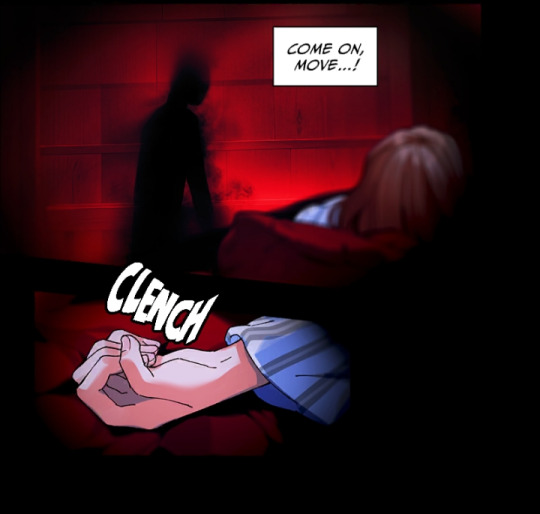
We learn later on that this is Zenji, and that Zenji is dead. MC seems to be reacting to his presence and I would like to think that the color choice is deliberate. If we go back to Episode 2, Takeru only has light amounts of red shading around him in his comic panels, when he kills the streamer and when Alan beats the shit out of him are two that immediately come to mind. Interacting with him does not turn the world red like interacting with Zenji or Kisaragi Station does, further strengthening Leo's conclusion about him being a Talupa and not a ghost as this red tint seems to be used for when MC is interacting with the spirit world. Which I am once again asking, how did Taiga get home from Kisaragi Station? Did he carjack a Taxi ghost?
This raises some questions about the anomaly that cursed MC. Is it a ghost and is it something unique to Japan? And if neither of those things are true then why was Haku there? I can think of two reasons for him to be there: the first is if he is there to keep an eye on Taiga for Cornelius/the Institute because Sinostra is on probation but they need him (he was specifically assigned this mission because of how aggressive he is) or it was meant to be a Hotarubi mission because it fit their criteria but Haku couldn't handle it so they arranged for Taiga to come along with him. That last thing is sort of countered by Haku saying that he doesn't think Hotarubi would be able to help with the MC's curse, but he could be lying about that I suppose.
Anyway who wants to hear my really stupid out there reason for why Haku is there-
The Part of the Show Where I do a line of coke Cope
So hear me out, what if Haku's stigma is time travel. So in this post on the subreddit donsaadali suggested that the powers you pick from in the personality test are powers the ring could give MC. I had the thought before that maybe it was a list of stigmas that the various characters had completely forgetting about the time travel line. But it does sort of fit with my line of thinking: make people follow my orders? That's Jin. Elemental powers? Towa. The others: extreme luck, never having to sleep, shapeshifting, and gravity control aren't ones that we have concrete information about but I am tempted to say that "extreme luck" could be Taiga, as turning things into ammo struck me as a quality of his artifact and not his stigma but I'm not really convinced of that. Anyway, if Haku can time travel, he could go back in time, pick up MC, and bring her back to Darkwick even if that's not what happened in the first place and Taiga was the one who brought her back the first time! But why he would do that is lost on me. Well not completely lost, I do think he wants to "help" her but with what and why is not something I have a theory on just yet.
To be clear, that was just me spitballing. I do not really think that Haku's stigma is time travel, there isn't enough evidence for me to think that. I do think that if there is a timeloop going on he is probably aware of it, but again. I don't know why.
Sources
Translated original post (x)
The above post also has a youtube video linked at the top if you want an audio version of the post and some other train related stories
Translated Twitter thread (x)
Shitty r/nosleep post (x)
112 notes
·
View notes
Photo

Vikings: Jewelry, Weapons & Social Change at The VIKINGR Exhibition
In April 2019 The Museum of Cultural History in Oslo, Norway opened its doors to the new exhibition VÍKINGR containing rich treasures and unique archaeological finds from the Viking Age (c. 750 - 1050 CE). The Viking age is considered Norway's and the rest of Scandinavia's “golden age”, and the tales of violent warrior seafarers have fascinated people all over the world for centuries. The Vikings are famous for their plundering of monasteries on the British Isles and the Viking helmet (wrongly depicted with horns in popular culture), but by visiting the VÍKINGR exhibition you will also learn that the Vikings were international traders, and that the Viking Age (c. 750 - 1050 CE) was an important period of transition in the northernmost part of Europe. This period saw the opening of new trade routes, the unification of Norway and the conversion to Christianity. The artifacts exhibited, including the world's best-preserved Viking helmet, the sword from Langeid and the largest Viking treasure ever found in Norway, are not only worth admiring for their beauty but also for what they can tell us about the Vikings' lives and values in a time of transition and change.
Walking into the exhibition, which is on the third floor of the museum, feels a bit like walking into a fancy jewelry store as it is beautifully curated with open spaces, complimentary colors and glass displays - very fitting for an exhibition consisting of invaluable jewelry, weapons, coins and other treasures. There are 20 items or collections of items on display, almost all inside the glass display cabinets, each telling their own story.
Trade & International Treasures
The first glass cabinets showcase jewelry and other items that are a testimony to the many different trade routes and international networks of the Vikings. The first Vikings of the 7th century CE were pirates in small ships, but by the 10th century CE they had built larger ships that traveled further and they established larger armies and contact points in Europe and beyond.
The items in the first display tell the story of the establishment of the silver route connecting Scandinavia with the distant east. The treasure, consisting of several silver pieces and rings, as well as Arabian and Persian coins, was originally from areas in today's Iraq and Iran. The silver treasure traveled the long way to Norway in the 10th century CE, when the Vikings who were engaged in international trade brought large amounts of silver back to Scandinavia. Further proof of the Vikings distant and exotic trade and international contact network can be seen in the next display, where the largest Norwegian Viking treasure ever found to date is showcased. The Hon Hoard was found in 1843 CE in Buskerud, Norway and consists of large gold rings, Frankish gold jewelry, Arabian coins, colorful beads, a Roman antique gemstone, and an English ring. Admiring this beautiful treasure makes you wonder what stories the items would tell of their long journeys and their Viking owners.
Especially eye-catching are some of the gold objects, originally made in the Carolingian Empire (800 - 888 CE). A large gold brooch is the most impressive piece, and it is believed to have adorned a warrior's belt at the Carolingian court before it was transformed into a brooch after coming to Norway. Other brooches are also showcased in the exhibition as they tell the story of objects that originally were used as decorative mounts on sacred objects used in churches in the British Isles. The objects were often refashioned into brooches after the Vikings raided many of these churches and brought the items back to Norway.
Continue reading...
45 notes
·
View notes
Text
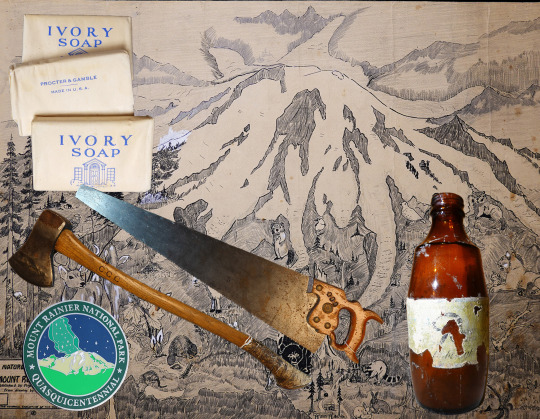
In 2024, Mount Rainier National Park celebrated its quasquicentennial, or the 125th Anniversary of its creation in 1899. The park has grown and changed a lot in those years! Pieces of its history have been preserved in the park’s archives. These objects and documents give a glimpse into the many events that have shaped the Mount Rainier National Park we know today.
A few of them are captured in the story map “Celebrating Mount Rainier’s 125th Anniversary with Artifacts”.
As we start the next year, what objects do you think will tell the park’s story in the future? What object or document tells YOUR story at Mount Rainier?
___ NPS Photos of some of the artifacts featured in the story map: 1930s drawing of Mount Rainier by the park’s first naturalist, Floyd Schmoe, 1930s saw and axe used by the Civilian Conservation Corps, beer bottle found in 2006 during excavations for the Jackson Visitor Center, soap found during the 2017-2019 rehabilitation of the Paradise Inn Annex, and the Mount Rainier 125th Anniversary challenge coin.
#mount rainier national park#125th Anniversary#history#historic artifacts#historic documents#Story Map#Mount Rainier history
23 notes
·
View notes
Text





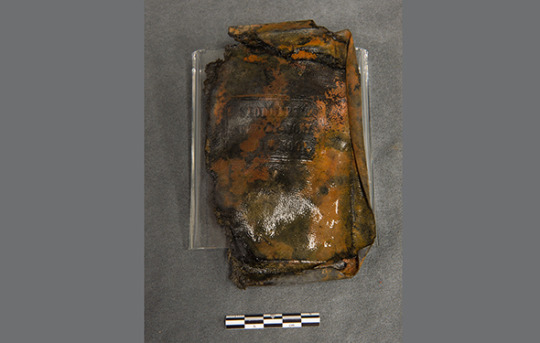

Artifacts recovered 2019 from the wreck of HMS Erebus - firstly from the Captain's Steward's pantry and the 3rd lieutenant's cabin.
From top to bottom, this pair of epaulettes, a toothbrush, plate, brush, a leather book cover embossed with "Stoddard's Preparatory Latin Book" and an ink bottle were recovered.
@clove-pinks
301 notes
·
View notes
Text

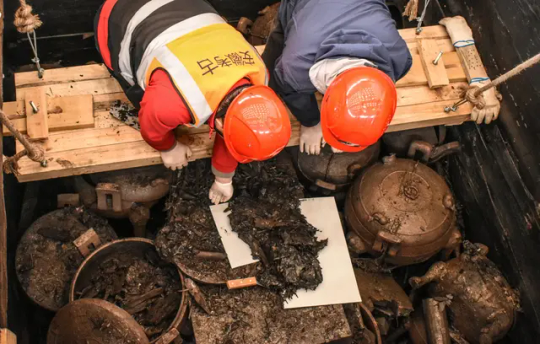
Lavish 2,200-year-old King Tomb Discovered in China
Archaeologists have unearthed a luxurious 2,200-year-old tomb in eastern China, the largest, highest-ranking, and most structurally complex ever unearthed, which may have belonged to an emperor of the state of Chu during a critical period in Chinese history.
Chu was one of the seven Warring States, along with Qin, Han, Wei, Zhao, Qi, and Yan. The unification of these states is recognized as the start of modern China.
The 2,200-year-old Wuwangdun tomb, which is situated in the Anhui Province of East China’s city of Huainan, has yielded over 1,000 artifacts, including figurines, musical instruments, bronze goods, and everyday utensils and lacquerware artifacts, dating to about 220 BC.
At Wuwangdun, one of the largest-scale Chu state archaeological sites, researchers previously uncovered a cemetery spanning 1.5sqkm, with a chariot and sacrifice pits and a tomb, believed to be that of the cemetery’s owner.
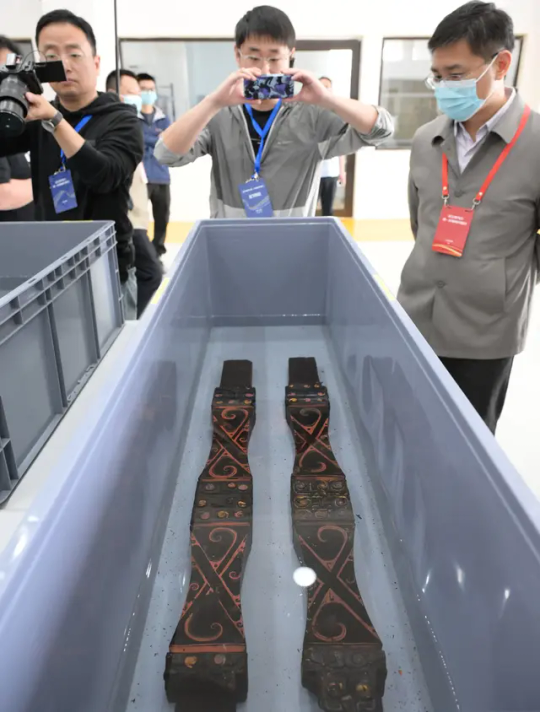



The tomb is thought to be the highest-level ancient Chu state tomb ever excavated, and its vast scale, intricate structure, and rich contents suggest it belonged to the state’s emperor.
According to information obtained by the Global Times newspaper from the Institute of Cultural Relics and Archaeology of Anhui Province, based on the size and scale of the tomb, as well as historical records, it is estimated that the owner of the tomb may be King Kaolie of Chu. However, a more accurate determination of the tomb’s occupant will require further extraction of artifacts and analyses of textual evidence.
Meanwhile, the tomb had been looted multiple times throughout history. Anhui was permitted by the NCHA in 2019 to excavate the tomb and salvage its archaeological remains. An official start to the excavation work was made a year later, and it was recognized as a national project to use archaeological research to determine the origins of Chinese civilization.
The Wuwangdun tomb complex, which covers an area of over 140 square kilometers, includes sacrificial pits, chariot and horse pits, accompanying graves, and the main burial chamber (Tomb No. 1). Tomb No. 1 is a large, nearly square, vertical pit tomb with sides that are about 50 meters long. There is a 42-meter-long, sloping tomb passage on the east side.
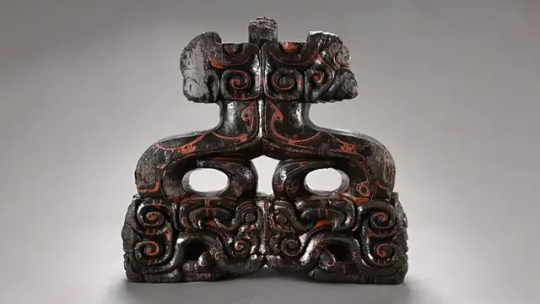


Around the pit, eight side chambers were found, and a central coffin chamber with several layers of planks covering it was also found. 443 coffin lid planks and the 78 bamboo mats that covered them have been removed thus far. On the planks of the coffin lid, there were about 1,000 ink-drawn characters that represented the locations and purposes of each side chamber.
“The findings can provide an overall picture of the political, economic, cultural, technological and social conditions of the Chu state in the Warring States period,” Gong Xicheng, an archaeologist part of the excavation told Chinese state news agency Xinhua.
“The findings can help us learn about the historical evolution as well as the formation of a unified nation and its culture,” he added.
These discoveries provide systematic archaeological data for studying the high-level tomb system in the Chu state during the late Warring States period (475BC-221BC).
To discover while also preserving the unearthed remains archaeologists worked within a special low-oxygen laboratory built at the site.
By Leman Altuntaş.



#Lavish 2200-year-old King Tomb Discovered in China#Wuwangdun tomb#Huainan China#King Kaolie of Chu#ancient tomb#ancient grave#ancient artifacts#archeology#archeolgst#history#history news#ancient history#ancient culture#ancient civilizations#ancient china#chinese history#chinese emperor#chinese art
97 notes
·
View notes